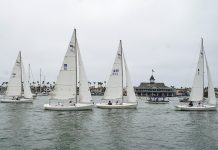Ahoy!
What if you can attend a boat show one day and then go snow skiing the next day? Kind of sounds like Southern California.
Well, this weekend you can attend the Denver Boat Show at the Colorado Convention Center on Saturday and then go skiing on Sunday before you head home. This brings back memories of when I was a college student when we would go body surfing in the mornings and then go night skiing at Snow Summit in Big Bear in the evenings.
It was possible back in those days because there was very little or no freeway traffic as you traveled up the 91 Freeway during rush hour. In those days, the stretch of 91 between Corona and the 55 Freeway was desolate, with no homes or buildings. Today, it is difficult to see where Anaheim Hills ends and Corona begins, not to mention the traffic, oh the traffic.
However, I digress.
Let’s get back to the waterfront, beginning with a press release I received from the Recreational Boaters of California. For years, the debate has continued over vessels’ bottom paints – which are too harmful to the environment and which actually work? T has to be balance between the two because too strong of antifouling elements will have a negative effect on the nearby organisms. Yet, a bottom paint with weak protection will accumulatively hurt the environment in the long run, too, with more frequent sanding and repainting, and deterioration of the hull. Most importantly, if the hull is not clean, then the drag, and this will require more energy for a boat to move through the water.
Sailboats under sail will simply go slower and feel sluggish with the additional growth, but boats under power will really notice a difference. A vessel under engine power – whether gasoline, diesel, or any new fuel type – will require more fuel to go at the normal cruising speed. I have seen a 10-plus percent increase in fuel consumption on yachts with “dirty hulls” and, for long distance yacht deliveries, I require the boat owner to have the hull cleaned prior to my arrival or my fuel calcs will be off. As an analogy, a dirty hull is similar to filling your car tires only to half the rated air pressure.
The marine growth on boats’ bottoms differ with the climate zone your boat is in. It’s very different in, for instance, the Pacific Northwest versus Southern California. You will have a much slower marine growth rate and the types of critters with a boat moored in the Pacific Northwest. The colder waters retard growth and there are not as many microorganisms free floating in the water, hence the clear waters.
However, Newport Harbor is a Petri dish, with our warm waters and numerous critters floating in the waters. I have seen primary marine growth on a boat’s hull after only half a day, and secondary marine growth in as little as two days. Once you have secondary growth, then the tertiary critters stake their homesteads, including tiny bay shrimp which I have seen just under a centimeter in size. (I will have to catch lots of these little critters for dinner.)
Through the years, copper has shown good results when added to bottom paints to help keep marine growth off the hulls. But there has been a movement in San Diego Harbor to ban copper in bottom paints. I have been asking for years for the empirical data that ties harbor copper levels directly to the boats.
We now have that data detailed in RBOC’s press release titled “New Scientific Work Raises Questions on Copper Rules.” The first paragraph reads, “A scientific presentation given in November of this year (2011) by the University of San Diego and Space and Naval Warfare Systems Command at The Society of Environmental Toxicology and Chemistry in Boston raises serious questions about the facts upon which regional and statewide actions are being taken that restrict the use of copper-based anti-fouling surfaces on boat hulls”.
This report is a thorough and a robust study of toxicity of water column samples, and the conclusions clearly rebuke much of the popular dialogue regarding copper and its toxicity. I will have more on this topic as I am still digesting the scientific finding, since it was almost 30 years ago when I minored in biology and chemistry.
The upshot of the week is let’s not stop at the easy target of boaters, but let’s go on land to ban copper roofs, copper rain gutters, copper weather vanes, copper pennies thrown into the water for luck, copper outdoor lights, copper mailboxes, copper cupolas, and the list goes on.
And don’t forget: Tune in to the No. 1 boating radio talk show in the nation, Capt. Mike Whitehead’s Boathouse Radio Show, broadcasting coast-to-coast on the CRN Digital Talk Radio syndicated network every Saturday at noon, Pacific Time and replayed on Sunday at 10 am Pacific. Join Chandler Bell, Craig Carpenter, and me as we talk about “all things boating.” You can find the station listings, cable TV channels, live streaming on the Internet, and now available are apps to listen to the show for your iPhone, Blackberry, iTouch, Android, Palm, and Windows Mobile at www.BoathouseTV.com or www.BoathouseRadio.com.
Until next week, Safe Voyages!





Keep up the great work, Captain Mike !
Walt Kadyk
RBOC President 2008
Ahoy Walt – Thank you for your support! However, you deserve credit as a director of Recreational Boaters of California – looking out for the average boater.